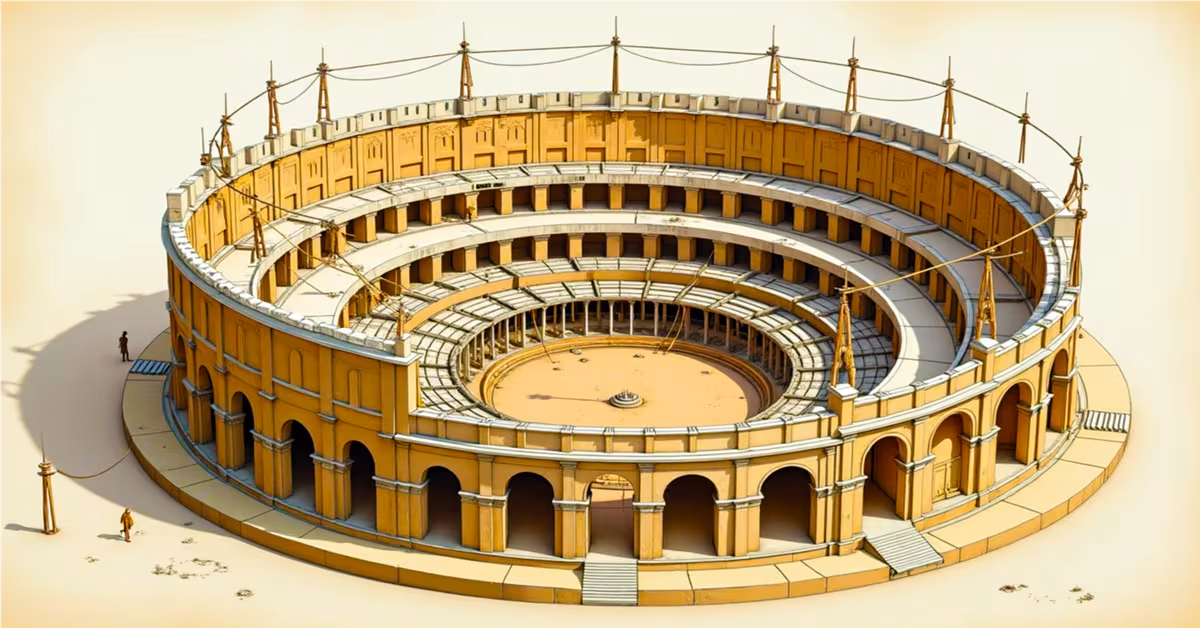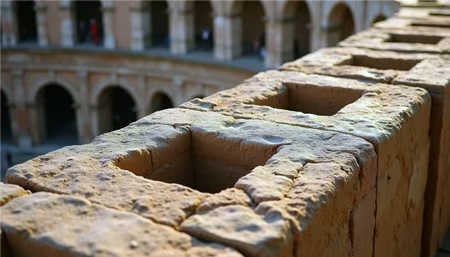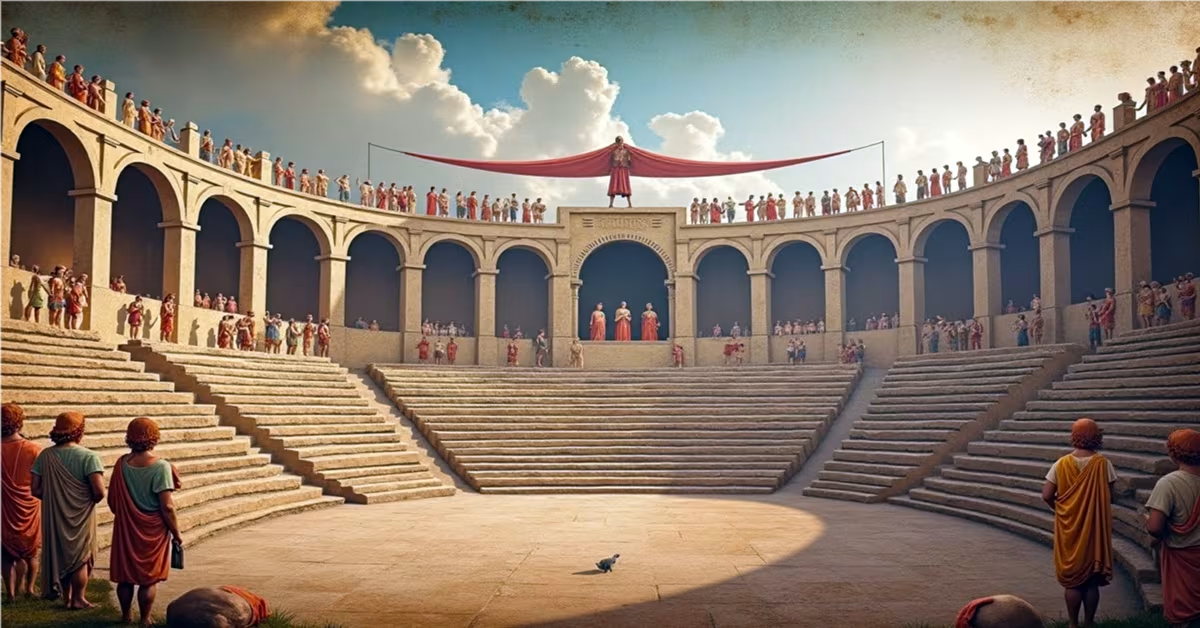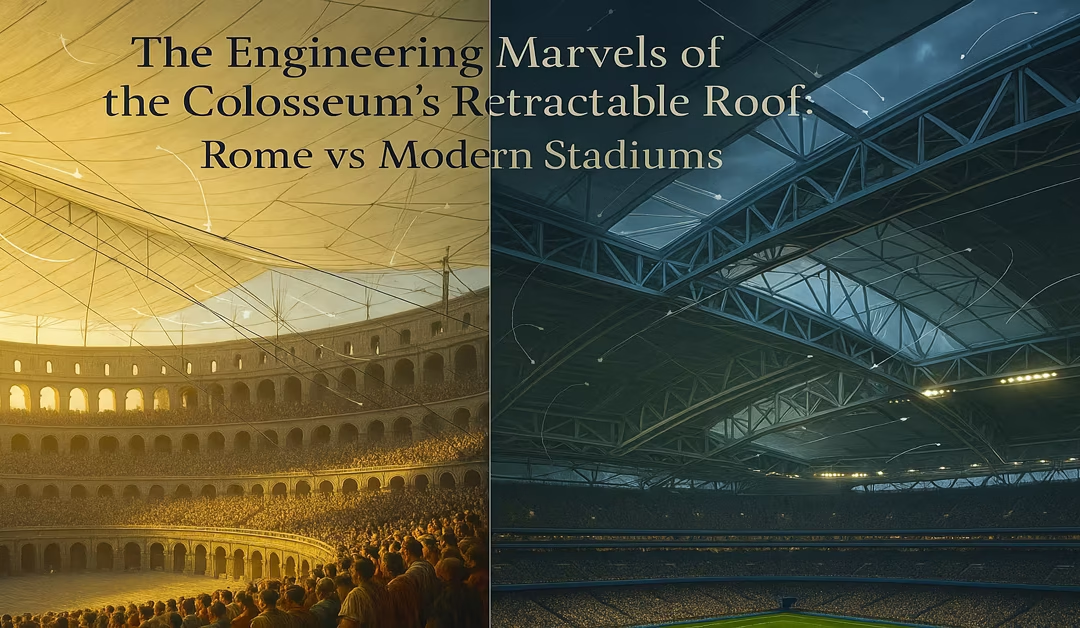Table of Contents
- 1 Why the Colosseum Still Astonishes Us?
- 2 Where is the Colosseum Located?
- 3 📌 Piazza del Colosseo, 1, 00184 Roma RM, Italy
- 4 What Exactly Was the Velarium?
- 5 How Did the Velarium Actually Work?
- 6 Colossal Scale and Engineering Challenges of the Velarium
- 7 🏺 Archaeological Evidence of the Velarium
- 8 Modern Comparisons: Rome vs Today’s Stadiums
- 9 Today’s Stadium Marvels with Retractable Roofs
- 10 The Roman difference: pure manpower & no steel
- 11 🏛️ Colosseum is Still the inspiration
- 12 ✈️How to Experience the Colosseum and Its Velarium Today
- 13 ✅ Conclusion: The Enduring Mystery & Glory of Roman Ingenuity
- 14 📚 References (APA style) Goes Here
Why the Colosseum Still Astonishes Us?
Discover the Colosseum’s ancient retractable roof! Explore Rome’s Velarium, unique engineering, and visitor tips. Uncover this marvel of Roman innovation. When most people think of the Colosseum in Rome, they picture its massive stone arches, roaring crowds, and epic gladiator battles. But hidden in its stones lies a lesser-known story: the incredible engineering of its retractable roof, or Velarium.
Imagine standing amid 50,000 cheering Romans, yet shielded from the scorching Mediterranean sun by a vast sail that stretched like a modern stadium roof. Nearly 2,000 years later, engineers still marvel at how the ancient Romans managed this feat — a retractable roofing system ahead of its time.
In this article, we’ll explore:
✅ Where is the Colosseum located, and how to reach it?
✅ Who built the Colosseum, and when?
✅ The technical design of the velarium (Colosseum retractable roof)
✅ The unique features that set it apart from all ancient structures
✅ Archaeological evidence proving this marvel existed
✅ How modern stadiums learned from Rome
✅ Insider visitor tips for seeing this marvel today
✅ And finally: Why the Colosseum stands as the ultimate ancient engineering wonder.
Where is the Colosseum Located?
The exact location of the Colosseum: The iconic Colosseum, formally known as the Flavian Amphitheatre, stands majestically at the crossroads of ancient and modern Rome. Nestled between three of Rome’s legendary seven hills — the Esquiline, Palatine, and Caelian Hills — it rises just to the east of the Roman Forum. This strategic location was no accident; it placed the amphitheatre at the very center of Roman civic life, ensuring it was easily accessible to citizens from all parts of the city. If you’re planning your visit, here’s the exact modern address:
📌 Piazza del Colosseo, 1, 00184 Roma RM, Italy
From this spot, you can literally walk in the footsteps of emperors, senators, gladiators, and countless spectators who once flocked here to witness grand spectacles.
🚉 How to reach the Colosseum today?
Thanks to Rome’s excellent public transport network, reaching the Colosseum is straightforward and part of the adventure.
🚇 By Metro: The simplest route is via Metro Line B (the Blue Line). Hop off at “Colosseo” station, and as soon as you exit the station, the mighty arches of the Colosseum greet you in all their glory.
🚌 By Bus: Numerous bus lines serve the Colosseum area, including routes 75, 81, 673, 175, and 204, each weaving through charming Roman neighborhoods before dropping you near this ancient wonder.
🚋 By Tram: Tram #3 stops just a stone’s throw from the monument, providing a scenic, above-ground option that lets you enjoy Rome’s street life along the way.
🚶 Walking: If you’re starting from Termini Station, Rome’s main transportation hub, it’s roughly a 20-minute stroll. Along the way, you’ll pass historic basilicas, quaint cafes, bustling piazzas, and artisan shops — making the approach to the Colosseum an experience in itself.
Visiting the Colosseum isn’t just about seeing a monument; it’s about soaking in the living tapestry of Rome.
Colosseum History, Who and when Built Colosseum?
The Colosseum stands as a towering testament to the ambition and engineering genius of the Flavian emperors. Construction began under Emperor Vespasian in AD 72, during a period when Rome sought to move past the extravagances of Nero’s reign. It was completed by his son, Emperor Titus, in AD 80, with further refinements added by Emperor Domitian.
This is why the Colosseum is often called the Flavian Amphitheatre — a name that honors the dynasty responsible for its creation.
But the choice of location was also politically savvy. The Flavians deliberately built the Colosseum over the artificial lake of Nero’s lavish Domus Aurea (Golden House) palace. By doing so, they symbolically gave this land “back to the people of Rome,” replacing imperial excess with public entertainment. It was a move that cemented their popularity and projected an image of humble, civic-minded leadership.
Materials and construction methods of Colosseum

The Colosseum was a masterpiece of Roman engineering, built to endure the test of time — and it has, surviving earthquakes, fires, and centuries of stone robbing. Here’s what made it so strong:
🏗️ Travertine limestone: Used for the grand outer walls, this light-colored stone from nearby Tivoli was prized for its strength and durability. Massive blocks were precisely fitted together, some weighing over 5 tons.
🌋 Tuff (volcanic stone): This lightweight material was ideal for the inner walls and supporting structures. It reduced the overall load while still providing excellent structural integrity.
🏛️ Roman concrete: Perhaps the real game-changer, this ancient concrete (a mix of lime, volcanic ash, and water) was remarkably resilient. It allowed the Romans to create massive vaults and arches that still stand today.
This ingenious combination of materials, along with a design that distributed weight through a network of arches and vaults, enabled the Colosseum to weather nearly two millennia of natural disasters and human intervention. Even after multiple earthquakes and centuries of looting, it remains one of the most recognizable and awe-inspiring landmarks on Earth.
Why this matters today
Standing before the Colosseum, you’re not just admiring an ancient ruin. You’re witnessing a brilliant blend of political strategy, community-building, and pioneering architecture — a structure that has literally shaped our modern understanding of what a stadium should be.
What Exactly Was the Velarium?
Imagine stepping into the Colosseum in ancient Rome. The crowd roars as gladiators clash below, but instead of baking under the fierce Italian sun, you find yourself comfortably shaded by a vast canopy overhead. That enormous retractable covering was called the velarium, a marvel of Roman engineering and design.
The velarium was essentially a gigantic, sail-like awning stretched over the top portions of the Colosseum — the cavea, or seating area — to shield tens of thousands of spectators from Rome’s relentless summer heat and occasional downpours. It was a technological wonder so advanced that its basic principles still echo in the retractable roofs of modern sports stadiums.
Fascinating Facts about the Velarium
📏 Enormous scale:
The velarium could cover roughly one-third of the Colosseum, primarily protecting the upper tiers where the less privileged sat. Considering the Colosseum held up to 50,000 spectators, this means thousands enjoyed relief from the blistering sun.
⚓ Operated by naval experts:
The complex rigging wasn’t handled by ordinary laborers. Instead, hundreds of sailors from Rome’s navy base at Misenum were specially assigned to Rome for this task. Their experience managing sails on vast Roman warships made them ideal for handling the velarium’s intricate network of ropes and pulleys.
🧵 Materials borrowed from the sea:
The fabric of the velarium was made from heavy-duty linen or canvas, identical to the material used for Roman naval sails. This ensured it was strong enough to withstand sudden gusts of wind without tearing.
Why Did the Romans Build It?
The practical answer is simple: to keep spectators cool and comfortable. Gladiator games and public spectacles often lasted hours, if not entire days, under Rome’s scorching sun. Without shade, watching these events could become unbearable — and even dangerous, given the risk of heatstroke.
But beyond comfort, the velarium served a deeper, almost psychological role. Its sheer scale and sophisticated mechanism were a public demonstration of Roman technological superiority. It wasn’t just about shading the crowds; it was about impressing them. Every time the sails unfurled, it was a vivid reminder of the empire’s wealth, organizational genius, and mastery over nature — a piece of subtle but powerful imperial propaganda.
How Did the Velarium Actually Work?
The brilliance of the velarium lies not just in the idea itself, but in how the Romans executed it. It combined architectural foresight with nautical skill to create what many consider the world’s first large-scale retractable roof system.
➡️ 240 sockets around the rim: Walk around the Colosseum’s top level today and you’ll still see 240 stone sockets cut into the outer ring. These were carefully positioned to hold huge wooden masts, which formed a towering circular framework all the way around the amphitheatre’s rim.

➡️ Ropes, pulleys, and rigging: From these masts extended an intricate network of ropes and pulleys, crisscrossing above the seating. Just like on a ship, sailors could pull on these ropes to adjust tension, secure sails, or rapidly unfurl them when the sun grew intense.
➡️ Massive linen sails: The sails themselves were divided into sections that could be rolled or folded back. Using winches and capstans, likely stationed at ground level around the perimeter, sailors could precisely extend or retract these huge linen panels, dynamically controlling how much of the stands were shaded.
This modular, ship-like approach allowed them to respond to changes in weather or wind direction in real-time — astonishing for a system operating nearly 2,000 years ago.
Who Operated This Gigantic System?
The velarium wasn’t something that could be managed by a few temple workers. Its scale required serious expertise.
👥 Approximately 1,000 sailors — drawn from the imperial fleet at Misenum (Rome’s largest naval base) — were stationed in Rome specifically to manage the velarium.
These were highly skilled men accustomed to handling enormous warship sails, making them uniquely qualified to control the vast linen canopy without risking disastrous collapses under strong gusts.
Their precise, disciplined teamwork meant the velarium could be quickly deployed or adjusted whenever the Mediterranean sun became too harsh, or if sudden rain threatened to dampen the games.
Natural Ventilation and Dramatic Lighting
The velarium was never designed to completely cover the Colosseum. Instead, it intentionally left a wide opening above the arena floor. This served two clever purposes:
Ventilation: With the center open, hot air rising from tens of thousands of bodies could escape upward, creating a natural “chimney effect.” This drew cooler breezes in through the archways and across the stands, keeping spectators surprisingly comfortable even on sweltering days.
A spectacular spotlight: Sunlight streaming through the central gap dramatically illuminated the sandy arena below. This turned gladiatorial contests and staged hunts into almost theatrical productions, with shafts of light spotlighting the combatants.
Why the Velarium Still Stuns Modern Engineers
Modern stadiums with retractable roofs, like London’s Wembley or Texas’s AT&T Stadium, rely on massive steel tracks, hydraulic motors, and computerized systems. Yet nearly 2,000 years ago, the Romans achieved a similar effect purely through human muscle, wooden masts, and expertly rigged rope systems.
Scholars and architects continue to study the velarium as a pioneering example of tensile architecture — using flexible materials under tension to create wide-spanning, semi-enclosed spaces.
When you visit the Colosseum today and gaze up at those silent stone sockets, remember: they once supported a spectacle almost as impressive as the gladiatorial games below — a billowing sea of sails, shifting with the sun and wind, an engineering masterpiece that brought Rome’s brilliance quite literally over the heads of its people.
Colossal Scale and Engineering Challenges of the Velarium

When we think of retractable roofs today, we imagine modern steel trusses, electric motors, and climate sensors. Now pause and consider this: nearly 2,000 years ago, Roman engineers designed a fabric canopy system for the Colosseum so vast and heavy that it still astonishes structural experts.
A staggering weight
Some modern structural engineers estimate that the velarium’s linen or canvas fabric alone — when fully extended — weighed over 24 tons (48,000 pounds). That’s not counting the miles of hemp ropes, wooden pulleys, iron fittings, or the huge timber masts needed to support and maneuver it.
Enormous stress on the structure
This immense weight and tension put colossal forces on every part of the system:
- The masts had to withstand huge lateral wind loads, just like a ship’s rigging in a gale.
- The ropes and anchors needed to be precisely distributed so no single point bore too much stress, which could cause catastrophic collapse.
- The stone sockets around the Colosseum’s upper rim had to be cut and positioned with incredible accuracy to hold the mast bases securely.
Remarkably, this was all achieved without modern engineering calculations, steel reinforcement, or cranes — relying purely on Roman ingenuity, experience from maritime engineering, and sheer manpower.
🏺 Archaeological Evidence of the Velarium
Given that the velarium was made of perishable materials like wood, hemp, and linen, it’s no surprise that none of the original canopy, rigging, or masts survive today. However, powerful clues in the stonework and ancient writings confirm exactly how this remarkable system worked.
🔍 What survives today?
- 240 post sockets: Still clearly visible around the top tier of the Colosseum, these rectangular cut-outs were designed to secure the bases of massive wooden masts. They formed a continuous ring around the amphitheatre, enabling the load of the canopy to be evenly spread.
- Grooves and notches: Along the outer walls, you’ll also find small grooves and carved channels. These likely helped anchor the ropes that held the sails taut, functioning much like cleats on a dock for tying ships.
- Ancient literary accounts: Writers such as Suetonius and Cassius Dio provided vivid descriptions of the velarium. They wrote of great billowing sails that shaded thousands, likening them to floating clouds or warships at sea. These poetic images give historians and engineers a narrative record that matches the physical evidence.
New 21st-century discoveries
In 2015, a team of German and Italian engineers and archaeologists used high-precision 3D laser scans to digitally model the top levels of the Colosseum. Their analysis confirmed that these sockets and grooves could only have supported a massive retractable awning system, validating centuries of historical speculation.
In fact, they concluded that the Colosseum’s velarium was the largest known retractable roof in the entire ancient world, outstripping anything else from classical antiquity.
Modern Comparisons: Rome vs Today’s Stadiums
The evolution of stadium roofing:
Today, we marvel at ultra-modern arenas that can open or close at the push of a button, shielding fans from rain or letting sunshine pour in during perfect weather. But when you compare these high-tech systems to what the Romans accomplished nearly 2,000 years ago, you begin to appreciate just how visionary their velarium truly was.
In fact, the Colosseum’s retractable roof remains the earliest known example of a stadium-scale tensioned fabric canopy, built purely from wood, ropes, and human power. Modern stadiums, by contrast, rely on:
- Gigantic steel trusses engineered to span hundreds of feet.
- Computerized motors and hydraulic actuators that move panels precisely.
- Real-time weather sensors that trigger automatic closures.
Yet despite this technological leap, the core principle remains eerily similar — using large modular sections to provide adaptable shelter for spectators.
Today’s Stadium Marvels with Retractable Roofs
🎾 Wimbledon Centre Court (London, UK)

Home of the world’s most prestigious tennis tournament, Wimbledon’s Centre Court unveiled its retractable roof in 2009.
- Engineering highlight:
Features 10 motorized steel trusses that slide giant translucent fabric panels across the court, closing in under 10 minutes.
Purpose:
Ensures rain never disrupts crucial matches, keeping global TV schedules intact
🏈 AT&T Stadium (Arlington, Texas, USA)
Often called “Jerry World,” this enormous NFL stadium is home to the Dallas Cowboys.
- Engineering highlight:
Boasts a massive 180,000 square foot retractable roof, along with the world’s largest operable glass doors. - Purpose:
Allows games under sun or stars, yet can quickly close for storms or extreme Texas heat.

⚾ Sapporo Dome (Hokkaido, Japan)
One of the most innovative multi-use stadiums in the world.
Engineering highlight:
Instead of just a roof, the entire natural grass field can be rolled outside on air cushions to get sunlight, while the stadium itself is covered by a retractable dome.
Purpose:
Keeps the turf healthy and lets the stadium instantly switch between baseball and soccer.

Mercedes-Benz Stadium (Atlanta, USA)
A spectacular feat of design opened in 2017. Engineering highlight:
Features a unique eight-panel retractable roof that opens like a giant camera aperture, creating an unforgettable visual experience.
Purpose:
Provides stunning natural light while maintaining quick closure for sudden weather shifts.

The Roman difference: pure manpower & no steel
What’s truly humbling is realizing that while these modern stadiums depend on advanced materials, sophisticated hydraulics, and digital precision, the Colosseum’s velarium did it all with timber, hemp ropes, and hundreds of skilled sailors pulling in perfect coordination.
- No electric motors.
- No weather sensors.
- No steel beams.
Yet it managed to cover large portions of the seating, shield crowds from the punishing Mediterranean sun, and withstand unpredictable gusts — all through ingenious engineering and raw human effort.
🏛️ Colosseum is Still the inspiration
Today’s architects and stadium designers continue to look back at Rome’s solution, studying how:
- The ring of masts distributed tension evenly around the elliptical structure.
- The chimney effect of leaving the center open actually improved ventilation — a concept modern stadiums still emulate to channel airflow.
So while our sports arenas may boast LED screens and climate controls, the Romans proved over two millennia ago that with enough creativity and craftsmanship, you could achieve truly monumental feats — long before anyone ever dreamed of electricity or steel I-beams.
🔍 Why the Colosseum still outshines them in ambition
The Romans did it with timber, rope, and human skill alone. No electricity. No steel cables. No automated sensors. This makes the Colosseum’s velarium arguably the world’s first large-scale tensioned fabric roof — a concept that modern architects still study when designing lightweight, aerodynamic structures.
Today’s engineers learn from the Romans about:
- Wind management: How open centers and staggered rigging reduce wind stress.
- Load distribution: The genius of evenly spaced mast sockets around the perimeter.
Modularity: The way sails could be pulled in sections, adjusting for sun and weather.
✈️How to Experience the Colosseum and Its Velarium Today
Morning (8:30 – 10:00 AM):
Enjoy cooler temperatures, softer light for photography, and fewer crowds.
Late afternoon (4:00 – 6:30 PM):
The sun casts a stunning golden glow on the ancient stones, perfect for capturing dramatic shadows in your photos.
Booking tickets smartly
- Buy online in advance.
This skips notoriously long ticket lines. Many tickets are combo passes that include the Roman Forum and Palatine Hill, giving you a full picture of Rome’s imperial core. - Consider a guided tour.
Specialized tours often take you to restricted areas like the top tiers, where you can see the mast sockets up close, or down to the hypogeum — the underground labyrinth where animals and gladiators prepared for their entrance.
What not to miss on-site
- Climb to the top level:
Here you’ll find the famous velarium post holes, a silent testament to Rome’s engineering genius.
Explore the hypogeum:
On a guided tour, descend below the arena floor to see elevators and trapdoors that once dramatically lifted beasts and fighters into the daylight — part of the same spectacular showmanship that justified having a giant canopy overhead.
🎇 Cultural & Historical Impact of the Velarium
In Roman literature & poetry
Roman poets like Martial loved to weave the velarium into their verses, comparing its vast linen sails to drifting clouds or mighty warships floating above the crowd. It was more than just shade — it was a symbol of Rome’s naval power and engineering prowess, projected right over the heads of its citizens.
In ancient and Renaissance art
- Frescoes and mosaics:
Several surviving artworks from Pompeii and other Roman sites depict amphitheatres draped in canopies, showing how common (and impressive) these awnings were to contemporaries. - Renaissance paintings:
Centuries later, artists like Piranesi romanticized Rome’s grandeur by illustrating the Colosseum with great billowing sails, embedding it deeper into the Western imagination.
The velarium was so central to Roman spectacle that it became an enduring image of imperial generosity and technological mastery — a cultural icon as much as an architectural one.
✅ Conclusion: The Enduring Mystery & Glory of Roman Ingenuity
So what does it all add up to? The Colosseum’s velarium stands not only as a feat of ancient engineering but as a timeless symbol of human ambition and creativity.
Nearly 2,000 years ago, without cranes, without digital models, without motors, Roman engineers managed to create a system that could shade 50,000 spectators with a vast canopy of billowing linen, expertly controlled by a corps of trained sailors.
Next time you stand inside the Colosseum’s mighty oval, pause and look upward. Imagine towering wooden masts bristling from the rim, sailors hauling ropes that creak under tension, and then — almost like a miracle — a vast ocean of sailcloth unfurling overhead, dimming the fierce Italian sun. That’s more than history; that’s the genius of Rome made tangible.
And it’s why, after all these centuries, the Colosseum remains not just the ultimate ancient stadium, but arguably the greatest engineering marvel the ancient world ever produced.
📚 References (APA style) Goes Here
- Boatwright, M. T. (2012). Hadrian and the Cities of the Roman Empire. Princeton University Press.
- Cassius Dio. (1925). Roman History (Vol. 5). Loeb Classical Library.
- Hopkins, K., & Beard, M. (2005). The Colosseum. Harvard University Press.
- Lancaster, L. (2005). Concrete Vaulted Construction in Imperial Rome. Cambridge University Press.
- Suetonius. (121 AD). The Lives of the Twelve Caesars.
- Througheternity.com. (2024). Was the Colosseum Covered? The Story of the Velarium.
- Wikipedia. (2025). Colosseum; Velarium.
- Italyrometour.com. (2024). The Colosseum’s Giant Awning.
- Questoapp.com. (2025). 15 Fascinating Facts About the Colosseum.

Trackbacks/Pingbacks